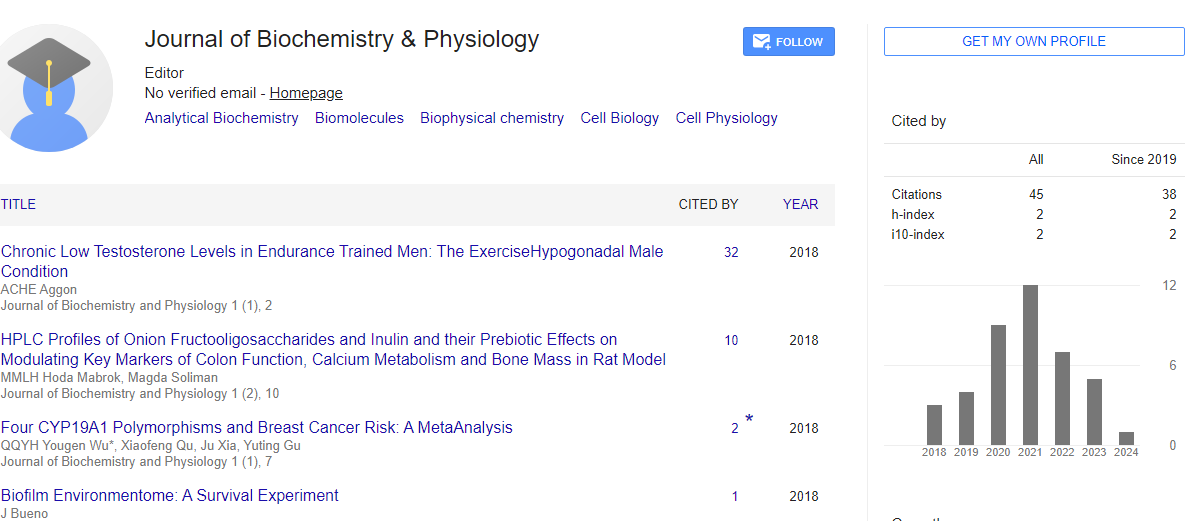Short Communication, J Biochem Physiol Vol: 6 Issue: 1
Principle Involved in EnzymeLinked Immunosorbent Assay (ELISA)
Suya Saita*
1Applied Life Science Department, Sojo University, Kumamoto, Japan
*Corresponding Author: Adamantia Nikolaidi, Oncology Clinic
Applied Life Science Department, Sojo University,
Kumamoto, Japan
E-mail: suyasaita@gmail.com
Received date: 20-Feb-2023, Manuscript No. JBPY-23-93417;
Editor assigned date: 22-Feb-2023, PreQC No. JBPY-23-93417 (PQ);
Reviewed date: 09-Mar-2023, QC No JBPY-23-93417;
Revised date: 16-Mar-2023, Manuscript No. JBPY-23-93417 (R);
Published date: 23-Mar-2023, DOI: 10.4172/jbpy.1000125
Citation: Saita S (2023) Principle Involved in Enzyme-Linked Immunosorbent Assay (ELISA). J Biochem Physiol 6:1.
Description
The Enzyme-Linked Immunosorbent Assay (ELISA) are a widely used laboratory technique for detecting the presence of specific antigens or antibodies in a sample. ELISAs are based on the principle of antigen-antibody binding, and they are commonly used in clinical and research settings to diagnose diseases, monitor immune responses, and measure protein concentrations [1,2].
Principles of ELISA
ELISAs use antibodies that are specific to the antigen of interest. These antibodies are typically conjugated to an enzyme, such as horseradish peroxidase or alkaline phosphatase, which catalyzes a reaction that produces a detectable signal [3-7]. The antigen of interest is immobilized on a solid support, such as a microplate, and the sample containing the test antibody is added to the plate. If the antigen is present in the sample, it will bind to the immobilized antibody, and the conjugated enzyme will catalyze a reaction that produces a detectable signal.
Types of ELISAs
There are several different types of ELISA, including direct ELISA, indirect ELISA, sandwich ELISA, and competitive ELISA [8]. Direct ELISA use a single antibody that is conjugated to an enzyme to detect the antigen of interest. Indirect ELISAs use two antibodies, one that is specific to the antigen of interest and one that is conjugated to an enzyme, to detect the antigen. Sandwich ELISAs use two antibodies, one that is immobilized on the solid support and one that is conjugated to an enzyme, to detect the antigen [9]. Competitive ELISA uses a labeled antigen and an unlabeled antigen to compete for binding to the immobilized antibody.
Applications of ELISAs
ELISA has a wide range of applications in clinical and research settings [10]. They are commonly used to diagnose and monitor infectious diseases, such as HIV and hepatitis, and to measure the concentration of specific proteins in biological samples. ELISAs are also used to detect antibodies against specific antigens, which can be useful for monitoring immune responses and diagnosing autoimmune disorders [11,12]. Some of the most common applications of ELISA include.
Diagnosis of infectious diseases: ELISAs are commonly used to diagnose infectious diseases, such as HIV, hepatitis, and Lyme disease. ELISAs can detect the presence of specific antibodies or antigens in a patient's blood or other bodily fluids, which can help to confirm a diagnosis.
Monitoring of immune responses: ELISAs can be used to measure the concentration of specific antibodies in a patient's blood over time. This can be useful for monitoring immune responses to vaccines or infections, or for diagnosing autoimmune disorders.
Detection of cancer biomarkers: ELISAs can be used to detect the presence of specific proteins in a patient's blood or other bodily fluids that may be indicative of cancer. For example, the Prostate-Specific Antigen (PSA) ELISA is commonly used to screen for prostate cancer.
Drug discovery and development: ELISAs can be used to screen large numbers of compounds for their ability to bind to specific proteins or to inhibit protein-protein interactions. This can be useful for identifying new drug targets or for developing drugs that target specific proteins or pathways.
Environmental monitoring: ELISAs can be used to detect the presence of specific contaminants, such as pesticides or heavy metals, in water or soil samples. This can be useful for monitoring environmental pollution and assessing the potential health risks associated with exposure.
 Spanish
Spanish  Chinese
Chinese  Russian
Russian  German
German  French
French  Japanese
Japanese  Portuguese
Portuguese  Hindi
Hindi 